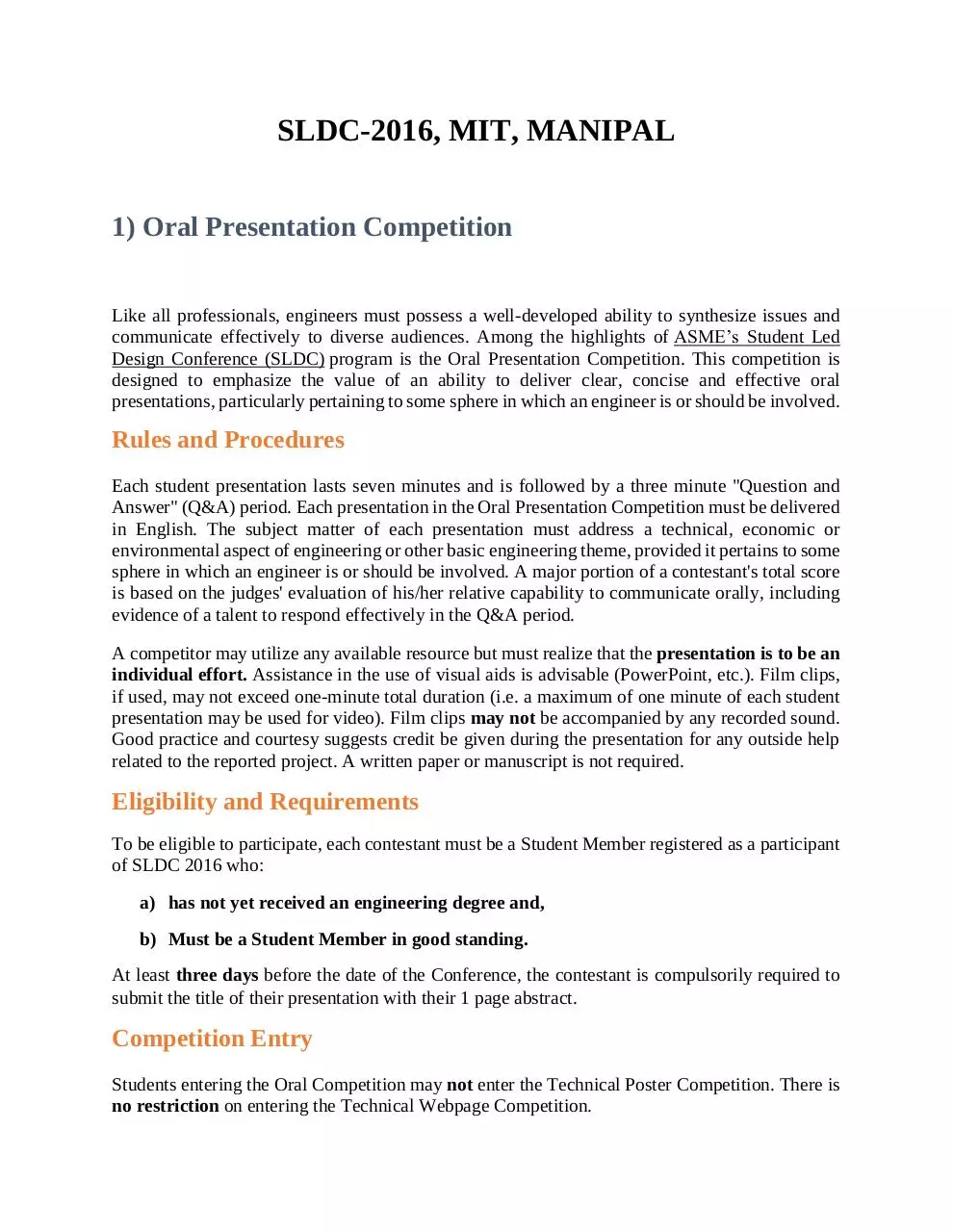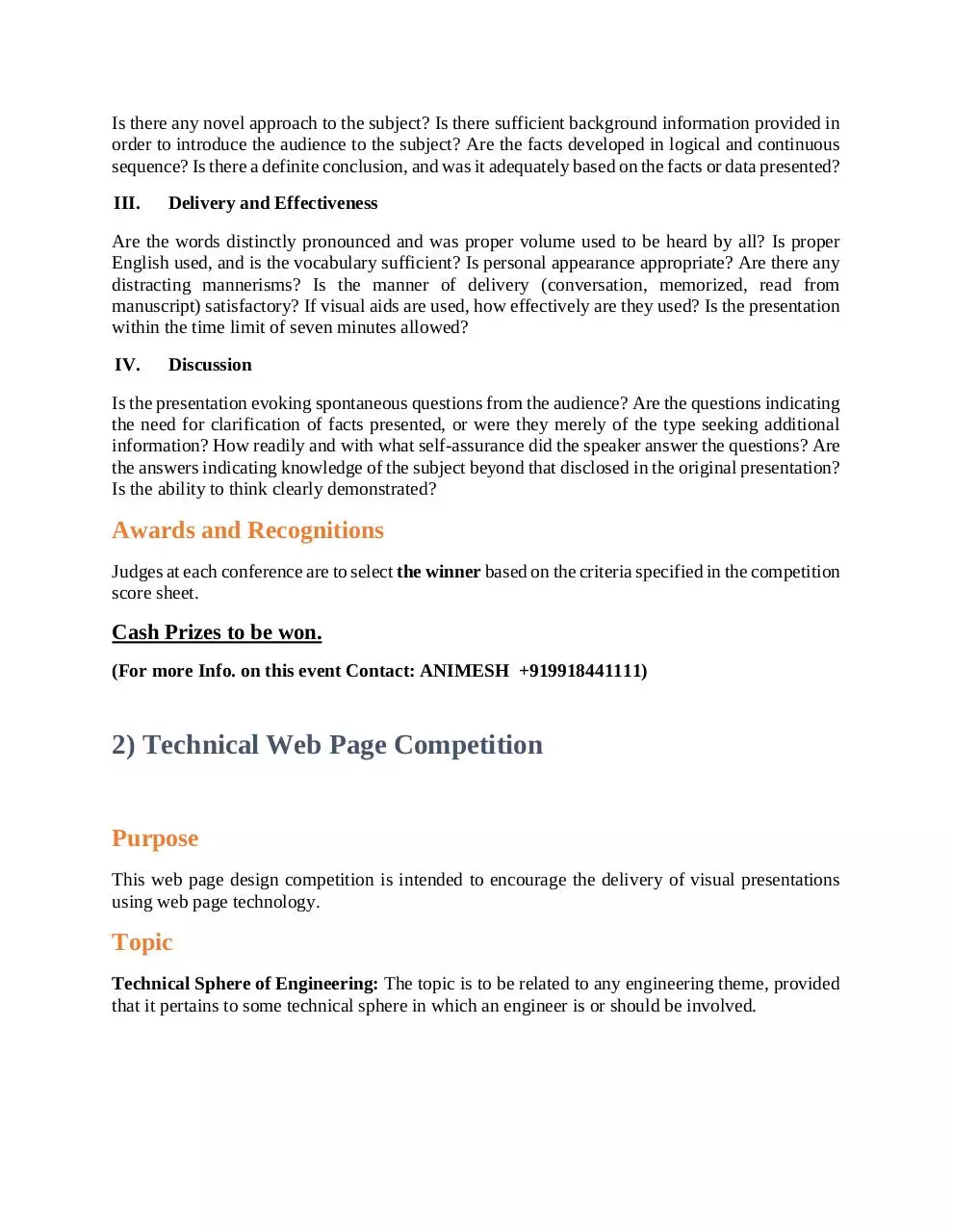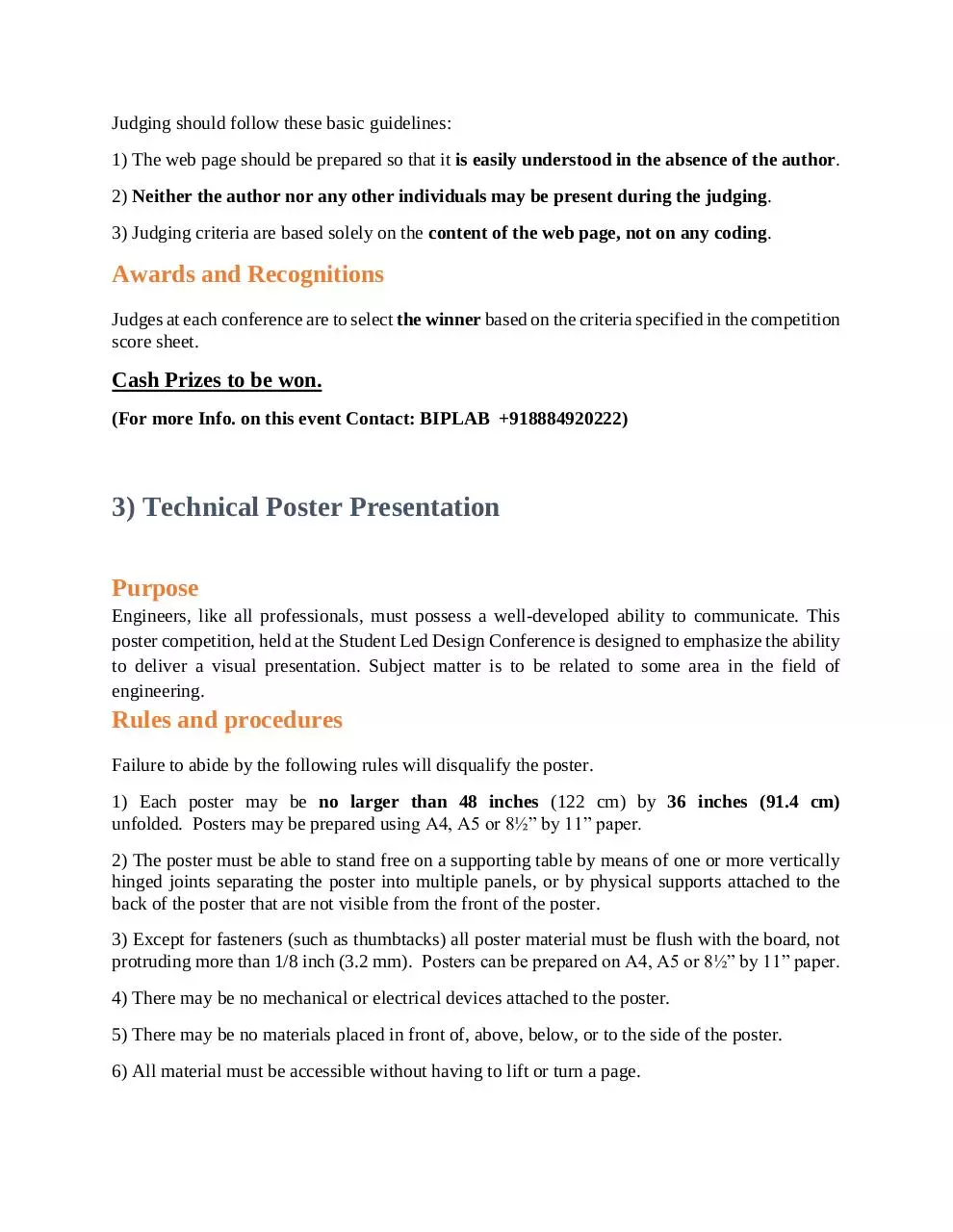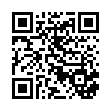SLDC Rule Book (PDF)
File information
Author: MAHE
This PDF 1.5 document has been generated by Microsoft® Word 2013, and has been sent on pdf-archive.com on 13/10/2016 at 20:01, from IP address 157.49.x.x.
The current document download page has been viewed 481 times.
File size: 454.38 KB (20 pages).
Privacy: public file





File preview
SLDC-2016, MIT, MANIPAL
1) Oral Presentation Competition
Like all professionals, engineers must possess a well-developed ability to synthesize issues and
communicate effectively to diverse audiences. Among the highlights of ASME’s Student Led
Design Conference (SLDC) program is the Oral Presentation Competition. This competition is
designed to emphasize the value of an ability to deliver clear, concise and effective oral
presentations, particularly pertaining to some sphere in which an engineer is or should be involved.
Rules and Procedures
Each student presentation lasts seven minutes and is followed by a three minute "Question and
Answer" (Q&A) period. Each presentation in the Oral Presentation Competition must be delivered
in English. The subject matter of each presentation must address a technical, economic or
environmental aspect of engineering or other basic engineering theme, provided it pertains to some
sphere in which an engineer is or should be involved. A major portion of a contestant's total score
is based on the judges' evaluation of his/her relative capability to communicate orally, including
evidence of a talent to respond effectively in the Q&A period.
A competitor may utilize any available resource but must realize that the presentation is to be an
individual effort. Assistance in the use of visual aids is advisable (PowerPoint, etc.). Film clips,
if used, may not exceed one-minute total duration (i.e. a maximum of one minute of each student
presentation may be used for video). Film clips may not be accompanied by any recorded sound.
Good practice and courtesy suggests credit be given during the presentation for any outside help
related to the reported project. A written paper or manuscript is not required.
Eligibility and Requirements
To be eligible to participate, each contestant must be a Student Member registered as a participant
of SLDC 2016 who:
a) has not yet received an engineering degree and,
b) Must be a Student Member in good standing.
At least three days before the date of the Conference, the contestant is compulsorily required to
submit the title of their presentation with their 1 page abstract.
Competition Entry
Students entering the Oral Competition may not enter the Technical Poster Competition. There is
no restriction on entering the Technical Webpage Competition.
1) Each presentation in the Oral Presentation Competition shall be made by one
contestant. Any questions regarding procedure shall be resolved in prior by the contestant
by communicating with host representatives before the Conference.
2) The Chair of the Host Student Section or any other representative may preside during
the contest and ensures that there is adherence to the time schedule given in the printed
program. The Presentation's duration is seven (7) minutes plus three (3) minutes for
Q&A immediately thereafter. Any time remaining or exceeding the seven minutes must be
added to or subtracted from the three minute discussion. No photographs may be taken
during the presentation; photographs may be taken during the question and answer period.
3) If time permits & judges are done with the questions, they may be asked by any
attendee of the competition except those from the competitor's own educational institution.
Each person posing a question to a speaker must stand, identify himself/herself and
school, and then proceed with the question.
4) The Host Student Section shall appoint two timekeepers which would be non-contestant
Student Members from the host institution.
5) At the end of four minutes, the first timekeeper will rise to signal to the speaker that
there are three minutes remaining. After the speaker nods to acknowledge the signal, the
timekeeper will sit down.
6) At the end of six minutes, the second timekeeper will rise to signal to the speaker that
there is one minute remaining. After the speaker acknowledges the signal, the timekeeper
will sit down.
7) At the end of seven minutes, both timekeepers will rise together and remain standing
until the speaker concludes the presentation. Both timekeepers will rise at the end of three
minutes to terminate the discussion period.
Judging and Scoring Criteria
In case of more registrations, liability to conduct competition in parallel with judges of same level
would be allowed.
The Presentations will be judged in four categories;
Content, Organization, Delivery and Effectiveness, and Discussion.
I.
Content
To what extent is the subject of interest to a technical audience? Is credit given for source of
material or contribution by others? How much knowledge of subject was exhibited? Is work
independent and original? Is the subject technical or general in nature?
II.
Organization
Is there any novel approach to the subject? Is there sufficient background information provided in
order to introduce the audience to the subject? Are the facts developed in logical and continuous
sequence? Is there a definite conclusion, and was it adequately based on the facts or data presented?
III.
Delivery and Effectiveness
Are the words distinctly pronounced and was proper volume used to be heard by all? Is proper
English used, and is the vocabulary sufficient? Is personal appearance appropriate? Are there any
distracting mannerisms? Is the manner of delivery (conversation, memorized, read from
manuscript) satisfactory? If visual aids are used, how effectively are they used? Is the presentation
within the time limit of seven minutes allowed?
IV.
Discussion
Is the presentation evoking spontaneous questions from the audience? Are the questions indicating
the need for clarification of facts presented, or were they merely of the type seeking additional
information? How readily and with what self-assurance did the speaker answer the questions? Are
the answers indicating knowledge of the subject beyond that disclosed in the original presentation?
Is the ability to think clearly demonstrated?
Awards and Recognitions
Judges at each conference are to select the winner based on the criteria specified in the competition
score sheet.
Cash Prizes to be won.
(For more Info. on this event Contact: ANIMESH +919918441111)
2) Technical Web Page Competition
Purpose
This web page design competition is intended to encourage the delivery of visual presentations
using web page technology.
Topic
Technical Sphere of Engineering: The topic is to be related to any engineering theme, provided
that it pertains to some technical sphere in which an engineer is or should be involved.
Rules and procedures
1) The web page must be contained within 100 megabytes (MB) and saved on a Flash drive
(USB). No compression may be utilized.
2) The web page must be operable on an IBM compatible machine; no MAC operating systems
will be provided.
3) Upon opening the Flash drive, there must be a file entitled “Start Web Page.” There should
be links on the “Start Web Page” file that will take the viewer to other files.
4) The web page must operate autonomously without the aid of secondary programs: i.e. FLASH,
QUICKTIME, SHOCKWAVE, etc., which must be added on the machine to view the web page.
These are prohibited.
5) No self-extracting executable files on the web page.
6) No audio on the web page.
7) Each entry may have only one author. However, ethical policies require credit to be given for
any assistance from other students or advisors. The name and affiliation of the author, and
acknowledgements, must be in a prominent place on the “Start Web Page file.
Platform
1) Microsoft Windows based operating system; not UNIX based.
2) A computer or laptop with a Pentium II or better will be provided. The web page cannot be
accessed through the internet; it must be on a Flash drive (100 MB limit).
Eligibility and Requirements
To be eligible to participate, each contestant must be a Student Member registered as a participant
of SLDC 2016 who:
a) has not yet received an engineering degree and,
b) Must be a Student Member in good standing.
Judging and scoring criteria
Web pages will be judged on content and the ability to portray the technical or specified
subject, not on code. To this extent, even “non-code-technical individuals are encouraged to make
use of programs such as Microsoft’s Front Page Express or other such programs to design their
own entry.
In case of more registrations, liability to conduct competition in parallel with judges of same level
would be allowed.
Judging should follow these basic guidelines:
1) The web page should be prepared so that it is easily understood in the absence of the author.
2) Neither the author nor any other individuals may be present during the judging.
3) Judging criteria are based solely on the content of the web page, not on any coding.
Awards and Recognitions
Judges at each conference are to select the winner based on the criteria specified in the competition
score sheet.
Cash Prizes to be won.
(For more Info. on this event Contact: BIPLAB +918884920222)
3) Technical Poster Presentation
Purpose
Engineers, like all professionals, must possess a well-developed ability to communicate. This
poster competition, held at the Student Led Design Conference is designed to emphasize the ability
to deliver a visual presentation. Subject matter is to be related to some area in the field of
engineering.
Rules and procedures
Failure to abide by the following rules will disqualify the poster.
1) Each poster may be no larger than 48 inches (122 cm) by 36 inches (91.4 cm)
unfolded. Posters may be prepared using A4, A5 or 8½” by 11” paper.
2) The poster must be able to stand free on a supporting table by means of one or more vertically
hinged joints separating the poster into multiple panels, or by physical supports attached to the
back of the poster that are not visible from the front of the poster.
3) Except for fasteners (such as thumbtacks) all poster material must be flush with the board, not
protruding more than 1/8 inch (3.2 mm). Posters can be prepared on A4, A5 or 8½” by 11” paper.
4) There may be no mechanical or electrical devices attached to the poster.
5) There may be no materials placed in front of, above, below, or to the side of the poster.
6) All material must be accessible without having to lift or turn a page.
7) Each entry may have only one author printed on the poster. However, ethical policies require
credit (acknowledgements) to be given on the poster for any assistance by other students or
advisors.
8) The name and affiliation of the author must be in a prominent place.
Eligibility
To be eligible to participate, each contestant must be a Student Member registered as a participant
of SLDC 2016 who:
a) has not yet received an engineering degree and,
b) Must be a Student Member in good standing.
Students entering the Technical Poster Competition may not enter the Oral Presentation
Competition. There is no restriction on entering the Technical Webpage Competition.
Judging
1) The poster should be prepared so that it is easily understood in the absence of the
author.
2) Neither the author nor any other individuals may be present during the judging.
3) Judging criteria are based solely on the content of the front of the poster.
Awards and Recognitions
Judges at each conference are to select the winner based on the criteria specified in the competition
score sheet.
Cash Prizes to be won.
(For more Info. on this event Contact: VYSHNAV +919743655150)
4) Video Presentation
Purpose
The Video Presentation Competition puts great emphasis on the value of an ability to deliver clear,
concise and effective presentations individually to an audience, particularly pertaining to some
scope in which an engineer is or should be involved. The subject matter of each presentation must
address a technical, economic or environmental aspect of engineering or other basic engineering
theme, provided it pertains to some sphere in which an engineer is or should be involved
Eligibility
To be eligible to participate, each contestant must be a Student Member registered as a participant
of SLDC 2016 who:
a) has not yet received an engineering degree and,
b) Must be a Student Member in good standing.
Rules and Procedures
1) A competitor may utilize any available resource but must realize that the presentation is
to be an individual effort. Assistance in the use of visual aids is permitted (PowerPoint,
etc.) but must appear clearly in the video.
2) The Presentation's duration is seven (7) minutes plus three (3) minutes for Q&A
immediately thereafter. Any time remaining or exceeding the seven minutes must be added
to or subtracted from the three minute discussion. No photographs may be taken during
the presentation; photographs may be taken during the question and answer period.
3) If time permits & judges are done with the questions, they may be asked by any
attendee of the competition except those from the competitor's own educational institution.
Each person posing a question to a speaker must stand, identify himself/herself and
school, and then proceed with the question.
4) The Host Student Section shall appoint two timekeepers which would be non-contestant
Student Members from the host institution.
5) At the end of four minutes, the first timekeeper will rise to signal to the speaker that
there are three minutes remaining. After the speaker nods to acknowledge the signal, the
timekeeper will sit down.
6) At the end of six minutes, the second timekeeper will rise to signal to the speaker that
there is one minute remaining. After the speaker acknowledges the signal, the timekeeper
will sit down.
7) At the end of seven minutes, both timekeepers will rise together and remain standing
until the speaker concludes the presentation. Both timekeepers will rise at the end of three
minutes to terminate the discussion period.
Judging and Scoring Criteria
In case of more registrations, liability to conduct competition in parallel with judges of same level
would be allowed.
The Presentations will be judged in four categories;
Content, Organization, Delivery and Effectiveness, and Discussion.
I.
Content
To what extent is the subject of interest to a technical audience? Is credit given for source of
material or contribution by others? How much knowledge of subject was exhibited? Is work
independent and original? Is the subject technical or general in nature?
II.
Organization
Is there any novel approach to the subject? Is there sufficient background information provided in
order to introduce the audience to the subject? Are the facts developed in logical and continuous
sequence? Is there a definite conclusion, and was it adequately based on the facts or data presented?
III.
Delivery and Effectiveness
Are the words distinctly pronounced and was proper volume used to be heard by all? Is proper
English used, and is the vocabulary sufficient? Is personal appearance appropriate? Are there any
distracting mannerisms? Is the manner of delivery (conversation, memorized, read from
manuscript) satisfactory? If visual aids are used, how effectively are they used? Is the presentation
within the time limit of 15 minutes allowed?
IV.
Discussion
Is the presentation evoking spontaneous questions from the audience? Are the questions indicating
the need for clarification of facts presented, or were they merely of the type seeking additional
information? How readily and with what self-assurance did the speaker answer the questions? Are
the answers indicating knowledge of the subject beyond that disclosed in the original presentation?
Is the ability to think clearly demonstrated?
Awards and Recognitions
Judges at each conference are to select the winner based on the criteria specified in the competition
score sheet.
Cash Prizes to be won.
(For more Info. on this event Contact: AISHWARYA +919833470084)
5) Invention Showcase
As the name indicates, this event features the identification of problems and edifying an
appropriate solution. This will have to be represented in front of judges’ expert panel and would
be judged on the following criteria.
Participation Criteria
This competition is aimed to increase the quality participation in ASME I-Show at India level.
Participants per group can be minimum 1 and maximum 3. Following are the points to be kept in
mind while evaluating this competition which would act as criteria for participants.
It should be a real time problem faced by the industries
It should be multi-disciplinary and
It should comprise of team work.
Presentation
This resembles a typical technical content presentation. Each team would present their solution to
the problem and research work. Participants have to present their individual contribution towards
the research work, from which individual performance can be easily evaluated.
Rules and Procedures
1) Each presentation in Invention Showcase shall be of made either by one contestant or
entire team. Any questions regarding procedure shall be resolved in prior by the
contestant by communicating with host representatives before the Conference.
2) Each team presentation lasts ten minutes and is followed by a five minute "Question
and Answer" (Q&A) period. Each presentation in the Invention Showcase must be
delivered in English. The subject matter of each presentation must address the issue and
its solution clearly.
3) The Chair of the Host Student Section or any other representative may preside during
the contest and ensures that there is adherence to the time schedule given in the printed
program. The Presentation's duration is ten (10) minutes plus five (5) minutes for Q&A
immediately thereafter. Any time remaining or exceeding the fifteen minutes must be
added to or subtracted from the five minute discussion. No photographs may be taken
during the presentation; photographs may be taken during the question and answer
period.
Download SLDC-Rule Book
SLDC-Rule Book.pdf (PDF, 454.38 KB)
Download PDF
Share this file on social networks
Link to this page
Permanent link
Use the permanent link to the download page to share your document on Facebook, Twitter, LinkedIn, or directly with a contact by e-Mail, Messenger, Whatsapp, Line..
Short link
Use the short link to share your document on Twitter or by text message (SMS)
HTML Code
Copy the following HTML code to share your document on a Website or Blog
QR Code to this page

This file has been shared publicly by a user of PDF Archive.
Document ID: 0000494352.